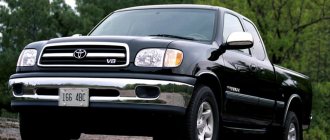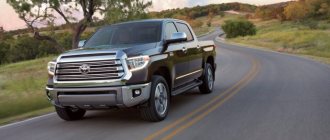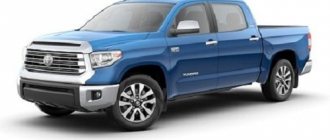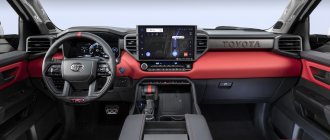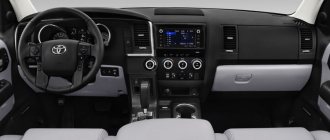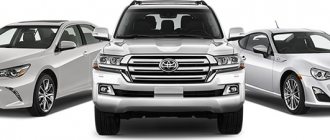New generation Toyota Tundra pickup truck presented
In the North American full-size pickup market, the Toyota Tundra is a laggard, selling only 121,000 vehicles last year. Only the already disastrous Nissan Titan sells worse (28 thousand), while the Big Three pickup trucks find 500-600 thousand buyers annually. But Toyota does not intend to leave this segment and has introduced a completely new third-generation Tundra.
The pickup truck is completely developed in the USA by engineering centers in Michigan, Arizona and California. There is nothing left of the previous second-generation truck, which lasted on the assembly line for 14 years. By the way, three years ago Toyota gave up on the “lower” corporate segment and curtailed the production of basic versions with a short two-door cab, so the new range includes only pickups with large four-door cabs, aimed primarily at private owners.
As before, there are two cabs to choose from: the standard Double Cab and the larger CrewMax. In the first case, the Tundra can have a cargo compartment length of 2.0 or 2.5 meters, and in the second - 1.7 or 2.0 meters. The cabin is still steel, but the cargo compartment is now composite with aluminum reinforcement inserts. The design of the pickup truck is decided in the new Technical muscle style, which was developed in the Californian Calty studio.
The new frame is much stiffer than the previous one: all elements have a box-section, the cross members are made twice as thick as before. Starting with the mid-range Limited trim level, the cabin is installed on hydraulic supports instead of the basic “monolithic” ones. The maximum load capacity of the pickup increased by 11% (to 880 kg), and the weight of the towed trailer increased by 17.6% (to 5.4 tons).
The suspension has been redesigned, with an unusually wide range of chassis options available for the Tundra. The double wishbone, typical for such cars, remains at the front, and the rear continuous axle is now suspended on springs instead of the previous springs. Twin-tube shock absorbers are installed all around. For an additional fee, you can order an adaptive suspension or a rear axle with air springs that allow you to change the ground clearance (Normal, Low and High positions are provided).
But that's not all. The TRD Sport package includes lowered coil springs, while the TRD Off-Road package includes Bilstein monotube shock absorbers, off-road ride modes, Crawl Control and a locking rear differential. Finally, the most advanced version of the TRD Pro features a 28mm higher ride height, Fox shocks with remote reservoirs, a stronger front stabilizer bar, additional underbody protection and all-terrain tires.
Like the Land Cruiser, the Toyota Tundra pickup has lost its classic V8 engine, and now it has the same V6 3.4 petrol biturbo engine as the Kruzak, which in its “truck” form is called i-Force. It produces 394 hp. and 649 Nm instead of 386 hp. and 544 Nm for the old G8. And the place of the six-speed automatic transmission was taken by a new ten-speed gearbox. Drive - rear or rigidly connected all-wheel drive with reduction gear.
And the Tundra also got a hybrid version, and we’re not talking about Toyota’s proprietary THS system with an electromechanical CVT. Another power plant, i-Force Max, has been developed for the frame pickup truck, which conceptually replicates hybrids from other manufacturers. An electric motor is built between the V6 biturbo engine and the ten-speed automatic transmission, and for movement on pure electric power, a friction clutch is embedded that disconnects the internal combustion engine. The output of the hybrid system is 443 hp. and 790 Nm.
The nickel-metal hydride traction battery is installed under the rear seat (in conventional gasoline versions there is a “trunk” there) and operates with a voltage of 288 volts. Its capacity is not named, but in electric mode the pickup can only accelerate to 29 km/h. And for towing trailers, a separate preset is provided, in which the internal combustion engine will run constantly. But there are still big doubts about the prospects of a hybrid pickup truck - such models are already offered by Ford and General Motors, but market success is small. There are much higher expectations from all-electric pickups.
The interior of the basic Tundra has dial gauges and an eight-inch media system screen. But the expensive versions now have virtual instruments (12.3 inches) and a large, 14-inch “TV” on the front panel. The multimedia itself is completely new, it works five times faster than the previous one, has voice control (to activate you need to say the phrases Hey, Hi, Hello or OK Toyota), an over-the-air update function, as well as Wi-Fi and 4G transmitters for connecting up to ten devices.
Options include ventilated front seats, a heated steering wheel, a large panoramic roof and much more. And the Safety Sense 2.5 set of electronic assistants is already included in the base: it includes automatic braking systems (recognizes pedestrians and cyclists) and lane keeping systems, as well as adaptive cruise control.
As before, the production of Toyota Tundra pickups will be carried out at a separate plant in Texas. Until now, the younger Tacoma model was also made here, but the new generation car will be produced in Mexico. But the next generation Toyota Sequoia SUV will be registered in Texas, which will be made on the basis of the new Tundra and will appear next year. The Tundra itself will hit the American market before the end of this year.
Review
The second generation Toyota Tundra has been in production for 14 years, but even such a long period of time does not diminish the interest in the, albeit frankly outdated, but still solid Japanese pickup truck, on the part of the classic American consumer.
More modern competitors from RAM and Ford are selling better today, but the situation risks changing, because the Japanese are introducing the third generation Tundra to the market - a completely modernized car that was developed by the company's engineering centers located in the States.
The manufacturer decided to abandon two-door modifications, so the new third-generation 2022 Toyota Tundra is basically a two-row one, but with two cab options - the regular Double Cab and the enlarged CrewMax.
The available length range of the luggage compartment is 1.7-2.5 meters, and unlike the steel cabin, the sides and rear side of the cargo platform have aluminum inserts. The front of the “muscular” car is made classically – with an emphatically massive front grille framed by an expressive C-shaped insert. There are also headlights with new graphics, “traced” wheel arches and a monolithic rear bumper built into the body.
New or used car?
Toyota has made only minor changes to the Tundra for 2021, adding a couple of new special editions. They focus on the 2021 Toyota Tundra's styling changes rather than feature and specification improvements. If you are not too attracted to trim levels with a new design, you can safely look for a model from previous years of production at the auto market. Toyota made the last major changes to the pickup truck in 2014, so you will have a large selection of used cars.
If you're really interested in the Toyota Tundra, there might be a completely new model coming next year. Spy photos on the Internet hint at this.
Salon
The new interior of the Tundra pickup looks more sleek and clean, the front console is located noticeably lower, but analog instruments still adorn the cheapest modification, as does a modest 8-inch multimedia display.
Of course, for an additional fee, the cockpit of this brutal car is seriously transformed: 12.3” digital instruments appear on the console, a huge 14” screen in the center, and a whole scattering of comfort options becomes available, including ventilation of the front seats, a panoramic roof, heated steering wheel and much more. etc. It is important that already in the initial configuration the new Tundra is equipped with the Safety Sense complex version 2.5, which contains all modern safety systems.
Toyota Tundra or Ford F-150
The Ford F-150 is always a contender for the top spot in pickup truck rankings because it does almost everything well. The F-150 can tow more than 5,895 kg, one of the highest in the class, and has a much higher payload capacity than the Tundra. Ford's truck offers a half-dozen engine options, from V6 to V8, as well as turbocharged and diesel powertrain options. The Ford also delivers a smoother ride and better handling than the Toyota. Additionally, while the F-150 isn't exactly a luxury car, it has an impressive interior with up-to-date comfort features.
How we tested the 2021 Toyota Tundra
Toyota Tundra or Toyota Tacoma
The Toyota Tacoma is a compact pickup truck, so it feels more like the Tundra's smaller brother than a serious competitor. Obviously, the Tundra model is larger, has a more spacious cabin and increased towing capacity. It also has a much more powerful engine. The Tacoma, on the other hand, feels modern, with better interior build quality and modern tech features. The Tacoma pickup is also a great off-road truck thanks to two TRD trims (TRD Off-Road and TRD Pro), and it gets better gas mileage than the Tundra.
Read also
How we tested the 2020 Toyota Tundra
Technical characteristics and filling
The 2022 Toyota Tundra gets rid of eight-cylinder engines and switches to the V6 from the Land Cruiser 300. The 3.4-liter i-Force gasoline unit is used in its “pure” form – on the base 394-horsepower version (649 Nm), and also in combination with an electric motor , increasing the output of the power unit to 443 hp. With. (790 Nm). The transmission is the same in both cases - a 10-speed automatic.

